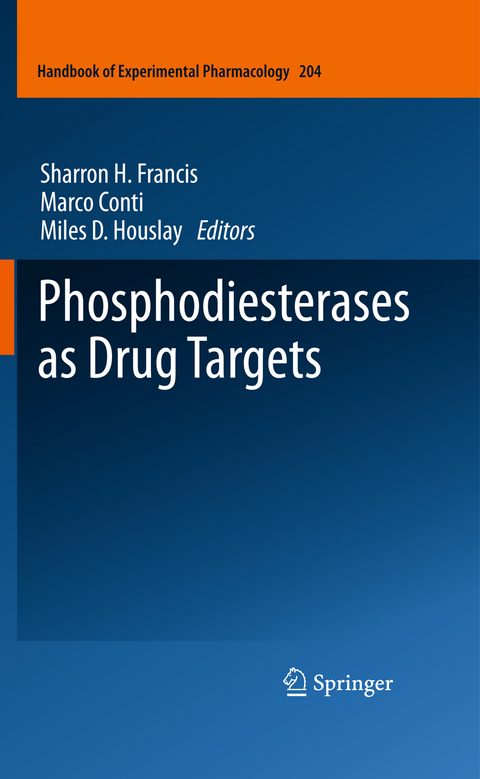
Phosphodiesterases as Drug Targets
Springer Berlin (Verlag)
978-3-642-26945-5 (ISBN)
Cyclic nucleotide phosphodiesterases (PDEs) are promising targets for pharmacological intervention. Multiple PDE genes, isoform diversity, selective expression and compartmentation of the isoforms, and an array of conformations of PDE proteins are properties that challenge development of drugs that selectively target this class of enzymes. Novel characteristics of PDEs are viewed as unique opportunities to increase specificity and selectivity when designing novel compounds for certain therapeutic indications. This chapter provides a summary of the major concepts related to the design and use of PDE inhibitors.
Phosphodiesterase inhibitors: History of pharmacology; PDE inhibitors: factors that influence potency, selectivity and action; A fission yeast-based platform for phosphodiesterase inhibitor high throughput screening and analyses of phosphodiesterase activity; The pharmacokinetics of PDE inhibitors and the impact of this on their efficacy and the therapeutic window; Structural insight into the substrate specificity of phosphodiesterases;The GAF-tandem domain of phosphodiesterase 5 as a potential drug target; Small molecule allosteric modulators of phosphodiesterase 4; PDE 2 holoenzyme-insights about full length PDE and mechanism of activation by cGMP binding; Harnessing the clinical efficacy of phosphodiesterase 4 inhibitors in inflammatory lung diseases with dual-selective phosphodiesterase inhibitors and novel combination therapies; PDE inhibitors in the treatment of inflammatory diseases; Cyclic nucleotides and phosphodiesterases in monocyte differentiation; PDEs as targets for modulating T cell responses; Role of PDEs in adult-onset pulmonary arterial hypertension; Phosphodiesterases: emerging therapeutic targets for neonatal pulmonary hypertension; Phosphodiesterase inhibition in heart failureEvaluation of the Therapeutic Utility of Phosphodiesterase 5A Inhibition in the mdx MouseModel of Duchenne Muscular Dystrophy; PDEs as targets for intermittent claudication;Treatment of erectile dysfunction and lower urinary tract symptoms by phosphodiesteraseinhibitors; Regulation of endothelial barrier function by cyclic nucleotides: the role of phosphodiesterases; Potential use of PDE inhibitors in treatment of depression and improvement of cognition; PDEs as targets for the treatment of basal ganglia disordersTherapeutic potential of PDE inhibitors in parasitic diseases
| Erscheint lt. Verlag | 26.11.2013 |
|---|---|
| Reihe/Serie | Handbook of Experimental Pharmacology |
| Zusatzinfo | XVIII, 522 p. |
| Verlagsort | Berlin |
| Sprache | englisch |
| Maße | 155 x 235 mm |
| Gewicht | 819 g |
| Themenwelt | Medizin / Pharmazie ► Medizinische Fachgebiete ► Pharmakologie / Pharmakotherapie |
| Medizin / Pharmazie ► Pharmazie | |
| Naturwissenschaften ► Biologie ► Biochemie | |
| Naturwissenschaften ► Biologie ► Zellbiologie | |
| Schlagworte | CAMP • cGMP • Inhibitors • medicinal chemistry • phosphodiesterases • Protein Structure • Signaling |
| ISBN-10 | 3-642-26945-1 / 3642269451 |
| ISBN-13 | 978-3-642-26945-5 / 9783642269455 |
| Zustand | Neuware |
| Informationen gemäß Produktsicherheitsverordnung (GPSR) | |
| Haben Sie eine Frage zum Produkt? |
aus dem Bereich


